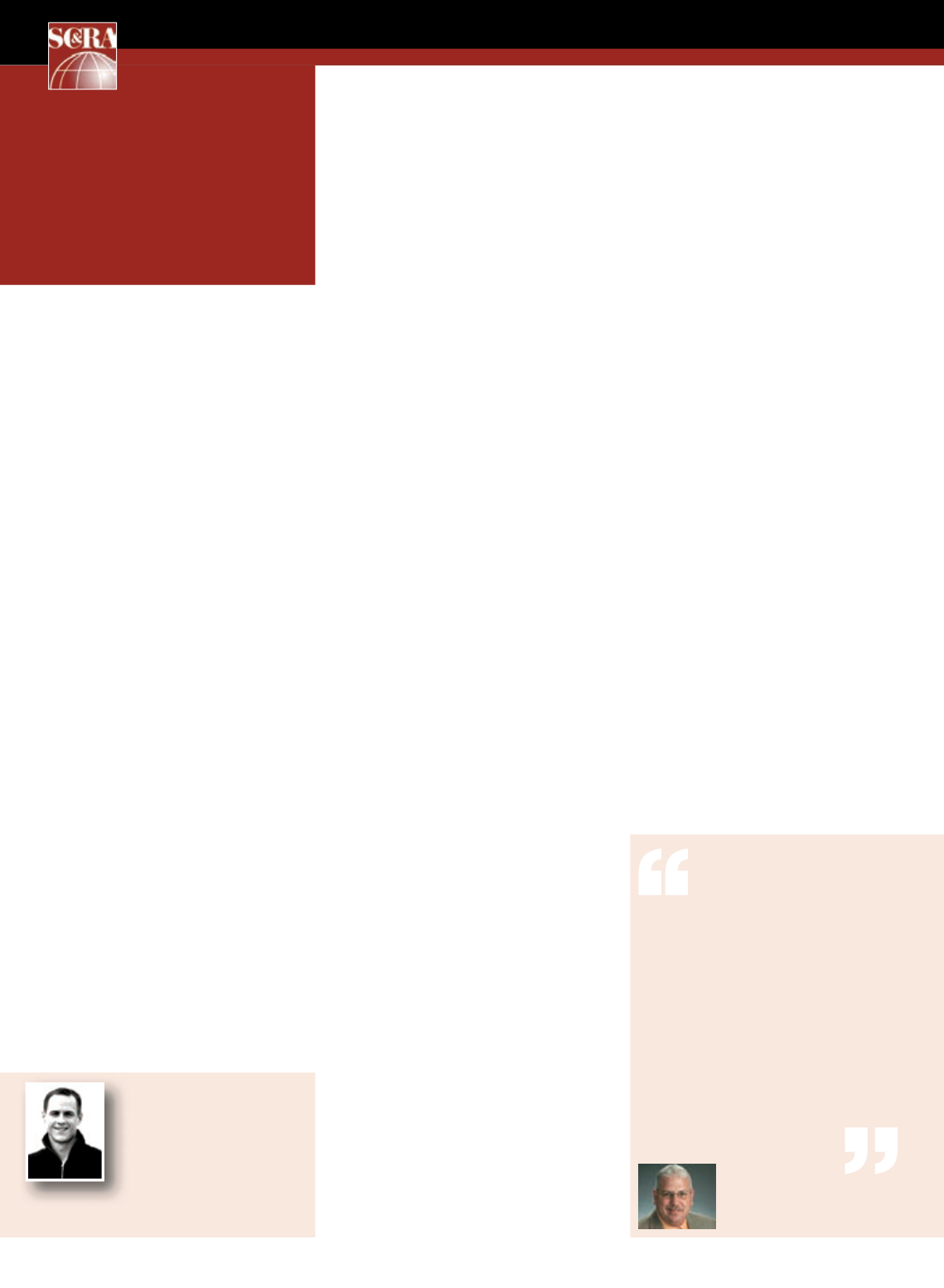
82
RISKMANAGEMENT
ACT
APRIL 2015
TimHillegonds
speaks
to John Schoppert and
Joe Doerr of NBIS about
the evolution of risk
management.
to them, andhow they thinkNBIS is
making a real difference in the industry.
PAINT THE PICTURE FORME, JOHN.WALKME
THROUGH THERISKMANAGEMENT EVOLUTION
FROM YOURPERSPECTIVE.
Sure. I’ll startwith the idea that it’s
perfectlynatural for humanbeings to
adopt thephilosophy “if it’s not broke,
don’t fix it.”Most people arenaturally
resistant to change. So in an eraof
great economic growth, such as the late
1990s through the early2000s, crane
companies hadno reason tomodify
their organizational goals. Businesswas
booming, companieswere growing at a
rapid rate, andnothing in the foreseeable
futurewould lead them tobelieve that
anythingdifferentwas coming.
BUT SOMETHING’SALWAYSCOMING, RIGHT?
Yeah. Sadly, itwas an increase in
accidents, injuries, workplace fatalities,
and liability lawsuits. Luckily, for all
parties involved, whilemany crane
companieswere focused solelyon top-line
growth, industry leaders such asNBIS
executive vicepresident Bill Smithwere
workingon trying to close someof gaps
left openby thebroadOSHA regulations
put inplacebyPresidentNixonwith the
foundingof theOccupational Safety and
HealthAdministration (OSHA) in1970
and the revisionof theASMEB30.5.
WHAT DO YOUMEANBY “GAPS?”
I’m referring to liability. See, the
unintended consequenceof themajor
economic growthof that timewas that
without an environmental changeof
culturewithin the industry,many small
contractorswereopenedupnot just
to liability for their ownnegligence–
whichwas really easy toplaceon them
do tobroad regulatory and statutory
requirements –but also for thenegligence
of others. Thatwouldbe thebeginning
of amovement thatwould forever
change thewaywe look at the value
of riskmanagement throughout the
construction industry. By the endof
2007, the economyhad collapsed, forcing
owners to look at – for someof them this
was the first time they’d looked at it – the
importanceof adopting a solid safety and
riskmanagement program throughout
their organization. Then in2009ASME
releasedB30.5. In2010, thenewOSHA
1400was put into circulation. These three
major eventswouldbe the foundation for
the transformation in an industry that for
decades followedonlyonepath.
JOE,WHATWAS YOURPATH LIKE COMING
INTO THE INDUSTRY?
When I first broke into the industry, I
was entering an environment that had
not changed inmanyyears. Themajority
ofmy training came from theoperator I
worked for, andhis training came from
theoperators beforehim. Thebasis of
the safety cultureback thenwas simply
learned from themistakes of others – a
see-what-happened-and-don’t do-that
typeof approach to safety.
AND THAT’SPRETTYDIFFERENT FROMWHERE
YOUSTAND TODAY. I KNOWNBIS’SRISK
MANAGEMENT ANDSAFETYPROGRAMSARE A
BIGPART OFWHAT SETS YOUGUYSAPART.
Definitely. Back then themajorityof
uppermanagement folks hadworked
theirwayup the ranks fromoperator,
truckdriver, rigger, etc. Their training
came inmuch the sameway thatmy
owndid, and thatwas reflected in their
views on riskmanagement through the
organization,making theprofitmargin
toppriority. This isnot toundermine
their attitudeon safety– they always
wanted toget the jobdone safely–but
getting the jobdone came first. Safety,
well, that came in a close second.We
Then and now
THEAUTHOR
TIMHILLEGONDS
spent a decade
in the heavy construction
insurance industry before
founding Thrive Content
Solutions, a copywriting agency
dedicated to helping businesses
tell their stories.
T
here’s a theme that prevails
inside theNBISoffices, and it
has todowith the following
idea: Inorder to insure an industry, you
need tobepart of the industry. But it’s
more than just a theme atNBIS, too. It’s
a reality. Threeof themen thatwork in
theRiskManagementDepartment are
actually former craneoperators –Billy
Smith, JohnSchoppert and JoeDoerr.
JohnSchoppert is a former safety
director and craneoperatorwithover
35years of experience in theheavy
construction industry.He travels the
countryperforming loss control audits
forNBISpolicyholders and is apart of
the shock loss unit supporting the claims
teamon large losses.He’s a certified crane
inspector, an integral part of the contract
management process, and a committee
chairmember for theANSIB30.5
committee,wherehehelps influencenew
safety standards for the crane and rigging
industry as awhole.
His counterpart, JoeDoerr, is a
graduateof the InternationalUnion
ofOperatingEngineers. Joe’s studied
general construction, safetymanagement
techniques, and crane and rigging
operations.He’s also aqualified rigger
and signalperson,NCCCO-certified, and
hasworked as both anoperator and lift
director.
Together, John and Joe spend their
days reviewing contracts, performing
field audits, reviewing and assisting
with the revisionof policyholders’ risk
management programs, anddeveloping
newonline trainingprograms.
I had a chance to talkwith John and Joe
todiscusswhat riskmanagementmeans
Business was
booming, companies
were growing at a rapid
rate, and nothing in the
foreseeable future would
lead them to believe that
anything different was
coming.
John Schoppert
Loss control manager
NBIS


